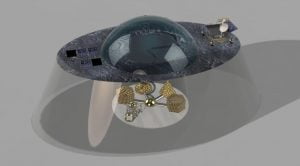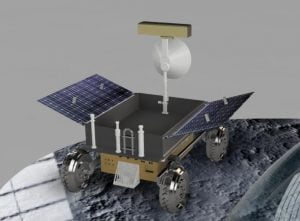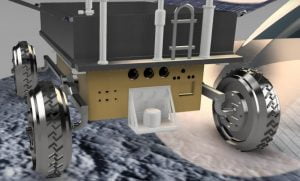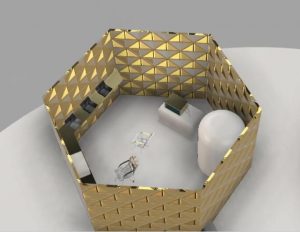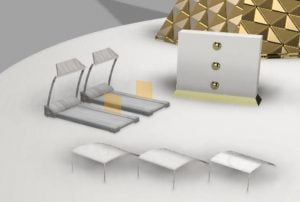Moon Camp Pioneers Gallery 2020-2021
In Moon Camp Pioneers each team’s mission is to 3D design a complete Moon Camp using Fusion 360. They also have to explain how they will use local resources, protect astronauts from the dangerous of space and describe the living and working facilities.
Team: Diana
Middle school affiliated to Zhengzhou University of light industry Zhengzhou City,Henan Province China 19
External viewer for 3d project
|
Project description
Our lunar camp is planned to be located underground, there are biological culture cabin, scientific research cabin and personnel training cabin underground. The external dome is designed to approximate the undulating lines on the surface of the moon. Through the dome, we can see the blue earth running in the universe. The underground lunar camp can protect astronauts from temperature and radiation. We choose to build honeycomb hexagonal cabins in the camp to save materials, and the interlayer materials of underground walls also have good temperature control effect and prevent oxygen leakage. Living in the lunar camp, astronauts will have independent workshops and rest places. The biological culture cabin will be equipped with a greenhouse to cultivate crops, and the scientific research cabin will conduct experiments such as sampling and research of lunar ore and ice storage. |
|||
|
Where do you want to build your Moon Camp?
I want to build my lunar camp in the north pole of the moon, because some places in the north pole can be illuminated by the sun all the year round, and the communication with the earth will not be interrupted by day and night changes. At the same time, there are potential volatiles, such as water, ice and other substances that can be extracted and utilized in the permanent dark areas near the polar regions. The bases in the polar regions of the moon can be exposed to extractable ice storage, special geographical environment and sunny highlands. How do you plan to build your Moon Camp? Describe the techniques and materials you would use.
We plan to build the lunar camp about 20 meters underground from the surface of the moon, and build a dome to protect the underground camp. First of all, the 20-meter soil has good heat preservation ability, and the temperature below the dome can be unaffected by the outside. And building the camp underground can keep out cosmic radiation and micro meteors and avoid radiation damage. The lunar soil rock is used as the material for building the lunar camp. Because of the vacuum on the lunar surface, high energy density and no air convection, the reflector can be directly used to focus and melt and consolidate the lunar soil. Due to abundant sunshine resources on the moon, the main components of the lunar soil structure are various metal oxides, which are electrolyzed after melting to directly obtain metal and oxygen. The melted lunar soil magma can be pumped to any place with high temperature resistant metal pipes for casting or 3d printing to make building components. The environment on the Moon is very dangerous for the astronauts. Explain how your Moon Camp will protect them.
There is no air on the surface of the moon, the temperature difference between day and night is large, the cosmic radiation is serious, and there are small meteors’ injuries. Therefore, we built the moon below the surface, and the underground soil has good heat preservation ability, which can maintain a comfortable temperature. Moreover, we built a thick dome on the surface of the vertical lunar camp to protect the lunar camp for the second time. Moreover, we built a lunar rover on the surface of the moon, which can replace astronauts to perform patrol, soil mining and other tasks in order to avoid the harm caused by astronauts leaving the camp. Explain how your Moon Camp will provide the astronauts with:
|
|||
|
Water
|
Food
|
Electricity
|
Air
|
|
As we intend to build the camp in the polar regions of the moon, the polar regions can be exposed to extractable ice storage. Astronauts control the lunar rover to the permanent shadow pit, use mirrors to reflect sunlight to melt ice, then capture water vapor through the dome above the lunar pit, and transport the obtained water back to the lunar camp. |
In the early stage, astronauts need to eat the food brought on the earth. We built a biological culture cabin in the lunar camp. In the later stage, astronauts can hydroponic cabbage and potatoes in a closed greenhouse illuminated by LED. The laboratory produces vitamin supplements and fats to ensure that astronauts can get the nutrients they need. |
Power is mainly generated by solar panels. Because our lunar camp is built on the highland where the polar sun shines, there is 90% sunshine all year round, and solar energy resources are abundant. The electricity converted from solar energy is converted into chemical energy and stored in energy batteries for the ventilation system and water circulation system of lunar rover and underground lunar camp. |
In the underground lunar camp, we built an oxygen generator, which generates hydrogen and oxygen through the electrolysis of water. At the same time, the plant culture cabin is connected with the living cabin through pipelines, and the photosynthesis is utilized to provide fresh oxygen for astronauts. |
|
Explain what would be the main purpose of your Moon Camp (for example: commercial, scientific, and/or tourist purposes).
The main purpose of our lunar camp is to conduct scientific research, gain a better understanding of the environment on the moon, and provide more experience for the full development of lunar resources. Astronauts in the lunar camp mainly adapt to the lunar environment, make full use of the local resources of the moon, and provide prerequisites for the rapid construction of a lunar city. |
|||
|
Describe a day on the Moon for your Moon Camp astronaut crew.
In the lunar camp, astronauts get up at 7 a.m and go to bed at 9 p.m according to their daily routine on the earth, and eat three meals a day. After getting up from the living room and eating breakfast, astronauts bring isolation masks and spacesuits into the central artificial gravity training cabin for two hours of exercise. Living in a low gravity environment will damage the quality of astronauts’ bones and muscles. By exercising under the earth’s gravity conditions, astronauts’ bodies can be prevented from being weakened for a long time. After breakfast, an astronaut enters the biological culture chamber and sets the temperature of the greenhouse to cultivate vegetables, fruits, crops and other plants. He can also try to raise animals like mice. Another astronaut entered the scientific research control cabin to carry out tasks such as excavating lunar soil and ice storage by remotely controlling the lunar rover on the lunar surface. After the ice storage and lunar soil are transported back to the camp through pipelines, astronauts can conduct lunar ore sampling research, lunar water extraction and other experiments. |
|||


